

Compact Muon Solenoid
LHC, CERN
| CMS-EXO-23-002 ; CERN-EP-2024-054 | ||
| Search for soft unclustered energy patterns in proton-proton collisions at 13 TeV | ||
| CMS Collaboration | ||
| 8 March 2024 | ||
| Submitted to Phys. Rev. Lett. | ||
| Abstract: The first search for soft unclustered energy patterns (SUEPs) is performed using an integrated luminosity of 138 fb$ ^{-1} $ of proton-proton collision data at $ \sqrt{s}= $ 13 TeV, collected in 2016-2018 by the CMS detector at the LHC. Such SUEPs are predicted by Hidden Valley models with a new, confining force with a large 't Hooft coupling. In events with boosted topologies, selected by high-threshold hadronic triggers, the multiplicity and sphericity of clustered tracks are used to reject the background from standard model quantum chromodynamics. With no observed excess of events over the standard model expectation, limits are set on the cross section for production via gluon fusion of a scalar mediator with SUEP-like decays. | ||
| Links: e-print arXiv:2403.05311 [hep-ex] (PDF) ; CDS record ; inSPIRE record ; Physics Briefing ; CADI line (restricted) ; | ||
| Figures | Summary | Additional Figures & Tables | References | CMS Publications |
|---|
| Figures | |
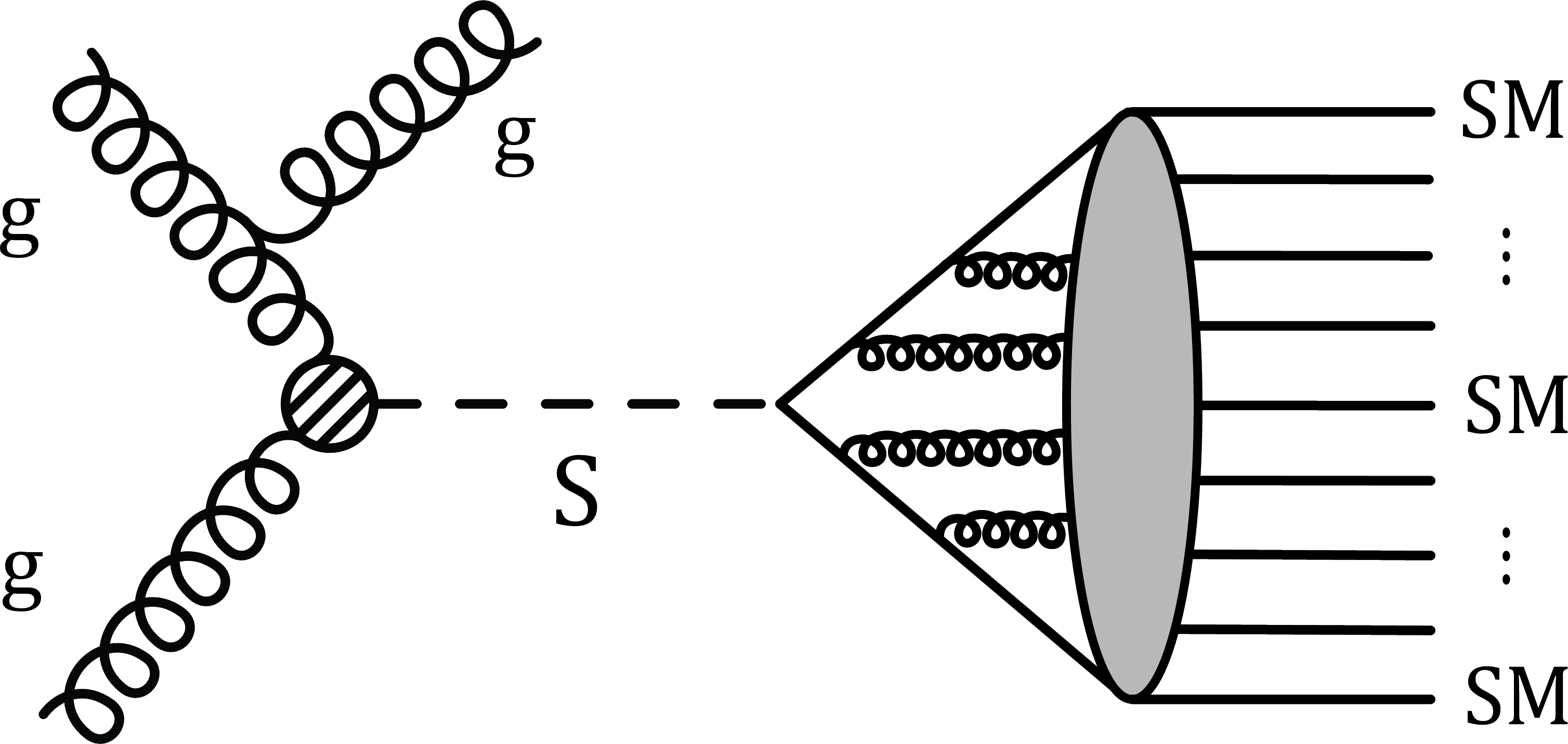
png pdf |
Figure 1:
A schematic Feynman diagram of the benchmark signal model resulting in a SUEP signature. |

png pdf |
Figure 2:
The number of observed events as a function of the number of tracks in the SUEP candidate, for all CRs A-H and the SR, as well as two signal samples. The three figures correspond to contiguous $ S^{\text{SUEP}}_{\text{boosted}} $ ranges. The pre-fit predicted background distribution is shown in the VR, the first bin of the SR. For all other regions and bins, the post-fit values for a background-only fit are shown. |

png pdf |
Figure 3:
The 95% CL exclusion limits on the production cross section $ \sigma $ are shown as a function of $ m_{\text{S}} $ for $ m_{\phi} = T_{\text{D}} = $ 3 GeV, for all decay modes. |
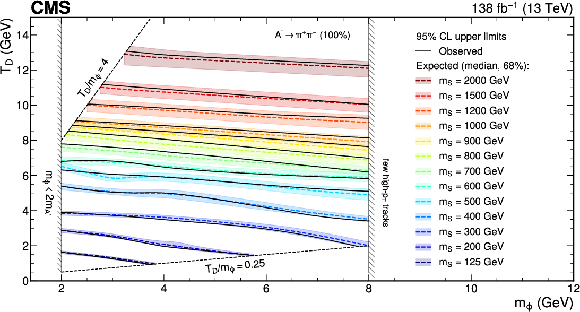
png pdf |
Figure 4:
The observed and expected exclusions for the nominal $ \text{S} $ cross section in the plane of $ m_{\phi} $ and $ T_{\text{D}} $, for various $ m_{\text{S}} $ values, for the case $ m_{{\mathrm{A}'}}= $ 1.0 GeV ($ {\mathrm{A}'} \to \pi^{+}\pi^{-} $ with $ \mathcal{B}= $ 100%). The regions below the observed limits are excluded. |
| Summary |
| In summary, this Letter presents the first search for soft unclustered energy patterns (SUEPs). Data corresponding to an integrated luminosity of 138 fb$ ^{-1} $ are used, collected with a trigger requiring a high scalar sum of jet transverse momenta and reconstructed with the full offline processing. This strategy preferentially selects events with initial-state radiation; the characteristic isotropic event shape of the SUEPs is recovered by boosting into the scalar mediator rest frame and removing the initial-state radiation particles. The number of tracks and the associated sphericity in the SUEP candidate are used to discriminate between the signal and the background from standard model quantum chromodynamics, which is estimated from data in suitable control regions. Stringent limits are placed on the most SUEP-like Hidden Valley scenarios with highly isotropic dark showers producing a large multiplicity of tracks. |
| Additional Figures | |

png pdf |
Additional Figure 1:
The 95% CL exclusion limits on the production cross section $ \sigma $ as a functions of $ m_{\text{S}} $ for various $ m_{\phi} $ and $ T_{\text{D}} $ values and all decay modes. |
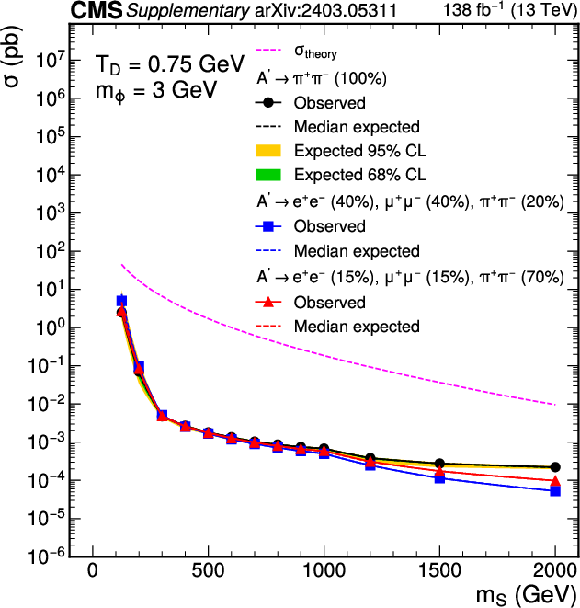
png pdf |
Additional Figure 1-a:
The 95% CL exclusion limits on the production cross section $ \sigma $ as a functions of $ m_{\text{S}} $ for various $ m_{\phi} $ and $ T_{\text{D}} $ values and all decay modes. |
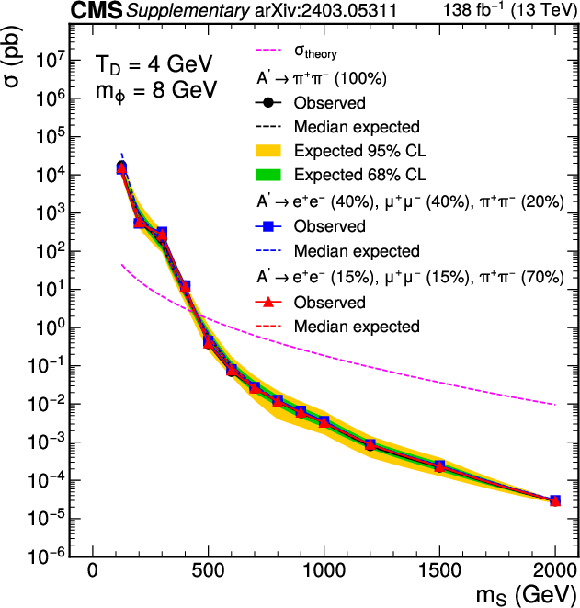
png pdf |
Additional Figure 1-b:
The 95% CL exclusion limits on the production cross section $ \sigma $ as a functions of $ m_{\text{S}} $ for various $ m_{\phi} $ and $ T_{\text{D}} $ values and all decay modes. |
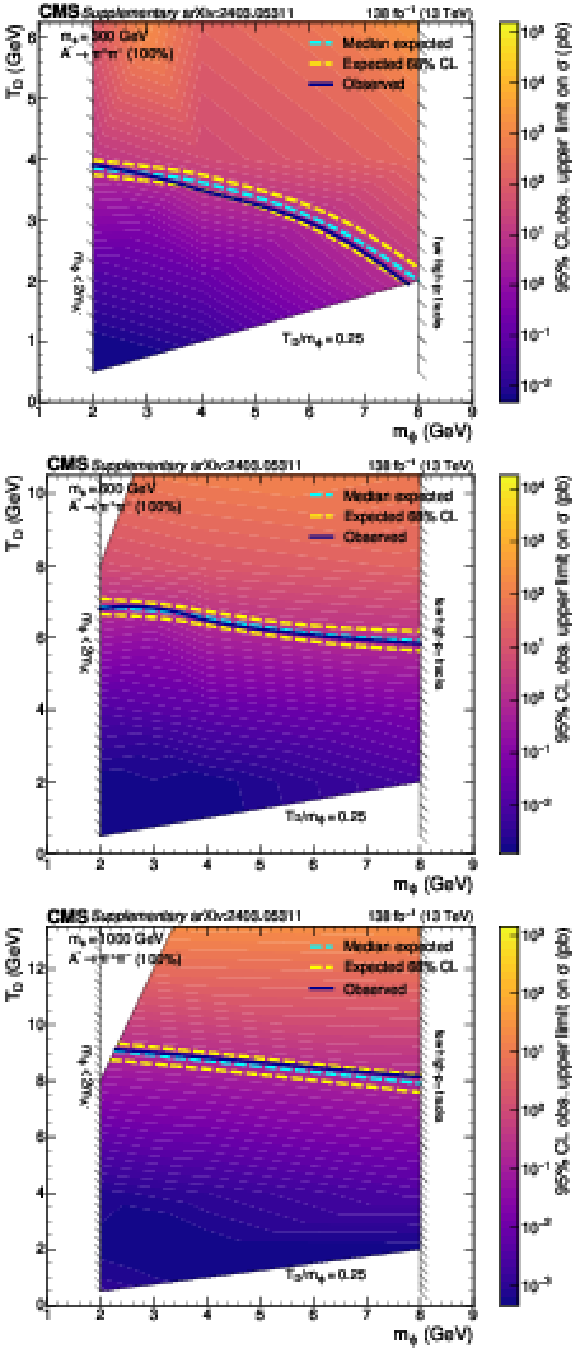
png pdf |
Additional Figure 2:
The 95% CL observed upper limits on the cross section as a function of $ T_{\text{D}} $ and the pseudoscalar mass $ m_{\phi} $ for $ m_{\text{S}} $ values of 300 GeV (upper), 600 GeV (middle), and 1000 GeV (lower), in the $ m_{\text{A}^{\prime}}= $ 1.0 GeV ($ \text{A}^{\prime} \to \pi^{+}\pi^{-} $ with $ \mathcal{B}=$ 100%) case. The solid dark blue curves indicate the observed exclusions for the nominal S cross section, while the dashed red curves indicate the expected exclusions, and the dashed light blue curves indicate the region containing 68% of the distributions of expected exclusions. The regions below the lines are excluded. |
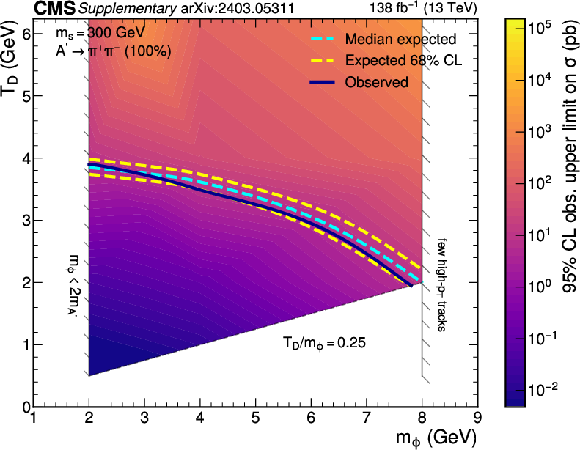
png pdf |
Additional Figure 2-a:
The 95% CL observed upper limits on the cross section as a function of $ T_{\text{D}} $ and the pseudoscalar mass $ m_{\phi} $ for $ m_{\text{S}} $ values of 300 GeV (upper), 600 GeV (middle), and 1000 GeV (lower), in the $ m_{\text{A}^{\prime}}= $ 1.0 GeV ($ \text{A}^{\prime} \to \pi^{+}\pi^{-} $ with $ \mathcal{B}=$ 100%) case. The solid dark blue curves indicate the observed exclusions for the nominal S cross section, while the dashed red curves indicate the expected exclusions, and the dashed light blue curves indicate the region containing 68% of the distributions of expected exclusions. The regions below the lines are excluded. |
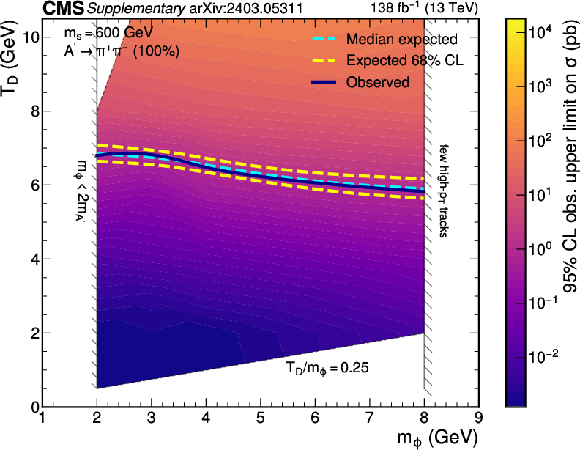
png pdf |
Additional Figure 2-b:
The 95% CL observed upper limits on the cross section as a function of $ T_{\text{D}} $ and the pseudoscalar mass $ m_{\phi} $ for $ m_{\text{S}} $ values of 300 GeV (upper), 600 GeV (middle), and 1000 GeV (lower), in the $ m_{\text{A}^{\prime}}= $ 1.0 GeV ($ \text{A}^{\prime} \to \pi^{+}\pi^{-} $ with $ \mathcal{B}=$ 100%) case. The solid dark blue curves indicate the observed exclusions for the nominal S cross section, while the dashed red curves indicate the expected exclusions, and the dashed light blue curves indicate the region containing 68% of the distributions of expected exclusions. The regions below the lines are excluded. |

png pdf |
Additional Figure 2-c:
The 95% CL observed upper limits on the cross section as a function of $ T_{\text{D}} $ and the pseudoscalar mass $ m_{\phi} $ for $ m_{\text{S}} $ values of 300 GeV (upper), 600 GeV (middle), and 1000 GeV (lower), in the $ m_{\text{A}^{\prime}}= $ 1.0 GeV ($ \text{A}^{\prime} \to \pi^{+}\pi^{-} $ with $ \mathcal{B}=$ 100%) case. The solid dark blue curves indicate the observed exclusions for the nominal S cross section, while the dashed red curves indicate the expected exclusions, and the dashed light blue curves indicate the region containing 68% of the distributions of expected exclusions. The regions below the lines are excluded. |
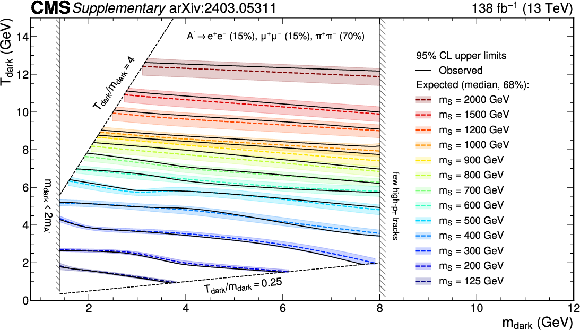
png pdf |
Additional Figure 3:
The observed and expected exclusions for the nominal S cross section for all $ m_{\text{S}} $ values, for the $ m_{\text{A}^{\prime}} = $ 0.5 GeV ($ \text{A}^{\prime} \to \mathrm{e}^+\mathrm{e}^-, \mu^{+}\mu^{-}, \pi^{+}\pi^{-} $ with $ \mathcal{B} = $ 40, 40, 20%) case, in the plane of $ m_{\phi} $ and $ T_{\text{D}} $. The regions below the lines are excluded. |

png pdf |
Additional Figure 4:
The observed and expected exclusions for the nominal S cross section for all $ m_{\text{S}} $ values, for the $ m_{\text{A}^{\prime}} = $ 0.7 GeV ($ \text{A}^{\prime} \to \mathrm{e}^+\mathrm{e}^-, \mu^{+}\mu^{-}, \pi^{+}\pi^{-} $ with $ \mathcal{B} = $ 15, 15, 70%) case, in the plane of $ m_{\phi} $ and $ T_{\text{D}} $. The regions below the lines are excluded. |

png pdf |
Additional Figure 5:
An example signal event from a representative model with $ m_{\text{S}}= $ 800 GeV in the lab frame (left) and the generator-level S mediator frame (right). The jets are clustered from charged particle tracks associated with the primary vertex using the anti-$ k_{\mathrm{T}} $ algorithm with $ R= $ 1.5. The size of each dot is scaled based on the $ p_{\mathrm{T}} $ of the corresponding track. |
| Additional Tables | |

png pdf |
Additional Table 1:
The observed and predicted yields in the SR, applying the extended ABCD method to the ISR candidate. Only statistical uncertainties are shown. The deviation of the ratio from unity, averaged across all years, is taken as a systematic uncertainty in the final SR prediction to address higher-order correlations between the variables used in the extended ABCD method. |

png pdf |
Additional Table 2:
The observed and predicted yields in the VR, which corresponds to the first bin in the SR, applying the extended ABCD method to the SUEP candidate. The statistical and systematic uncertainties are shown separately. (The VR is not used in the final fit.) |

png pdf |
Additional Table 3:
The numbers of observed and predicted (post-fit) events for each SR bin. |

png pdf |
Additional Table 4:
For a selection of signal samples in era 2018 with $ m_{\phi} = T_{\text{D}} = $ 3 GeV, the relative efficiencies and the total efficiency with respect to the selection on the generator-level $ H_{\mathrm{T}} $, $ H_{\text{T}}^{\text{gen}} > $ 1000 GeV. |
| References | ||||
| 1 | M. Cvetic, P. Langacker, and G. Shiu | Phenomenology of a three family standard like string model | PRD 66 (2002) 066004 | hep-ph/0205252 |
| 2 | Z. Chacko, H.-S. Goh, and R. Harnik | The twin Higgs: Natural electroweak breaking from mirror symmetry | PRL 96 (2006) 231802 | hep-ph/0506256 |
| 3 | M. J. Strassler and K. M. Zurek | Echoes of a hidden valley at hadron colliders | PLB 651 (2007) 374 | hep-ph/0604261 |
| 4 | T. Hur, D.-W. Jung, P. Ko, and J. Y. Lee | Electroweak symmetry breaking and cold dark matter from strongly interacting hidden sector | PLB 696 (2011) 262 | 0709.1218 |
| 5 | S. A. Abel et al. | Kinetic mixing of the photon with hidden U(1)s in string phenomenology | JHEP 07 (2008) 124 | 0803.1449 |
| 6 | Y. Bai and P. Schwaller | Scale of dark QCD | PRD 89 (2014) 063522 | 1306.4676 |
| 7 | M. J. Strassler | Why unparticle models with mass gaps are examples of hidden valleys | 0801.0629 | |
| 8 | S. Knapen, S. Pagan Griso, M. Papucci, and D. J. Robinson | Triggering soft bombs at the LHC | JHEP 08 (2017) 076 | 1612.00850 |
| 9 | G. Elor, N. L. Rodd, and T. R. Slatyer | Multistep cascade annihilations of dark matter and the galactic center excess | PRD 91 (2015) 103531 | 1503.01773 |
| 10 | CMS Collaboration | Search for microscopic black hole signatures at the Large Hadron Collider | PLB 697 (2011) 434 | CMS-EXO-10-017 1012.3375 |
| 11 | S. C. Park | Black holes and the LHC: A review | Prog. Part. Nucl. Phys. 67 (2012) 617 | 1203.4683 |
| 12 | A. Costantino, S. Fichet, and P. Tanedo | Effective field theory in AdS: Continuum regime, soft bombs, and IR emergence | PRD 102 (2020) 115038 | 2002.12335 |
| 13 | S. Amoroso, D. Kar, and M. Schott | How to discover QCD instantons at the LHC | EPJC 81 (2021) 624 | 2012.09120 |
| 14 | CMS Collaboration | HEPData record for this analysis | link | |
| 15 | P. Schwaller, D. Stolarski, and A. Weiler | Emerging jets | JHEP 05 (2015) 059 | 1502.05409 |
| 16 | CMS Collaboration | Search for new physics with emerging jets in proton-proton collisions at $ \sqrt{s} = $ 13 TeV | Submitted to \emphJHEP, 2024 | CMS-EXO-22-015 2403.01556 |
| 17 | T. Cohen, M. Lisanti, and H. K. Lou | Semivisible jets: Dark matter undercover at the LHC | PRL 115 (2015) 171804 | 1503.00009 |
| 18 | CMS Collaboration | Search for resonant production of strongly coupled dark matter in proton-proton collisions at 13 TeV | JHEP 06 (2022) 156 | CMS-EXO-19-020 2112.11125 |
| 19 | M. Graham, C. Hearty, and M. Williams | Searches for dark photons at accelerators | Ann. Rev. Nucl. Part. Sci. 71 (2021) 37 | 2104.10280 |
| 20 | S. Knapen, J. Shelton, and D. Xu | Perturbative benchmark models for a dark shower search program | PRD 103 (2021) 115013 | 2103.01238 |
| 21 | J. Alwall et al. | The automated computation of tree-level and next-to-leading order differential cross sections, and their matching to parton shower simulations | JHEP 07 (2014) 079 | 1405.0301 |
| 22 | T. Sjöstrand et al. | An introduction to PYTHIA 8.2 | Comput. Phys. Commun. 191 (2015) 159 | 1410.3012 |
| 23 | CMS Collaboration | Extraction and validation of a new set of CMS PYTHIA8 tunes from underlying-event measurements | EPJC 80 (2020) 4 | CMS-GEN-17-001 1903.12179 |
| 24 | NNPDF Collaboration | Parton distributions from high-precision collider data | EPJC 77 (2017) 663 | 1706.00428 |
| 25 | GEANT4 Collaboration | GEANT4---a simulation toolkit | NIM A 506 (2003) 250 | |
| 26 | J. Barron et al. | Unsupervised hadronic SUEP at the LHC | JHEP 12 (2021) 129 | 2107.12379 |
| 27 | CMS Collaboration | The CMS experiment at the CERN LHC | JINST 3 (2008) S08004 | |
| 28 | CMS Collaboration | Performance of the CMS Level-1 trigger in proton-proton collisions at $ \sqrt{s} = $ 13 TeV | JINST 15 (2020) P10017 | CMS-TRG-17-001 2006.10165 |
| 29 | CMS Collaboration | The CMS trigger system | JINST 12 (2017) P01020 | CMS-TRG-12-001 1609.02366 |
| 30 | CMS Collaboration | Electron and photon reconstruction and identification with the CMS experiment at the CERN LHC | JINST 16 (2021) P05014 | CMS-EGM-17-001 2012.06888 |
| 31 | CMS Collaboration | Performance of the CMS muon detector and muon reconstruction with proton-proton collisions at $ \sqrt{s}= $ 13 TeV | JINST 13 (2018) P06015 | CMS-MUO-16-001 1804.04528 |
| 32 | CMS Collaboration | Description and performance of track and primary-vertex reconstruction with the CMS tracker | JINST 9 (2014) P10009 | CMS-TRK-11-001 1405.6569 |
| 33 | CMS Collaboration | Particle-flow reconstruction and global event description with the CMS detector | JINST 12 (2017) P10003 | CMS-PRF-14-001 1706.04965 |
| 34 | CMS Collaboration | Technical proposal for the Phase-II upgrade of the Compact Muon Solenoid | CMS Technical Proposal CERN-LHCC-2015-010, CMS-TDR-15-02, 2015 CDS |
|
| 35 | M. Cacciari, G. P. Salam, and G. Soyez | The anti-$ k_{\mathrm{T}} $ jet clustering algorithm | JHEP 04 (2008) 063 | 0802.1189 |
| 36 | M. Cacciari, G. P. Salam, and G. Soyez | FastJet user manual | EPJC 72 (2012) 1896 | 1111.6097 |
| 37 | CMS Collaboration | Jet energy scale and resolution in the CMS experiment in pp collisions at 8 TeV | JINST 12 (2017) P02014 | CMS-JME-13-004 1607.03663 |
| 38 | C. Cesarotti, M. Reece, and M. J. Strassler | The efficacy of event isotropy as an event shape observable | JHEP 07 (2021) 215 | 2011.06599 |
| 39 | S. Choi and H. Oh | Improved extrapolation methods of data-driven background estimations in high energy physics | EPJC 81 (2021) 643 | 1906.10831 |
| 40 | CMS Collaboration | Precision luminosity measurement in proton-proton collisions at $ \sqrt{s} = $ 13 TeV in 2015 and 2016 at CMS | EPJC 81 (2021) 800 | CMS-LUM-17-003 2104.01927 |
| 41 | CMS Collaboration | CMS luminosity measurement for the 2017 data-taking period at $ \sqrt{s} = $ 13 TeV | CMS Physics Analysis Summary, 2018 CMS-PAS-LUM-17-004 |
CMS-PAS-LUM-17-004 |
| 42 | CMS Collaboration | CMS luminosity measurement for the 2018 data-taking period at $ \sqrt{s}= $ 13 TeV | CMS Physics Analysis Summary, 2019 CMS-PAS-LUM-18-002 |
CMS-PAS-LUM-18-002 |
| 43 | CMS Collaboration | Measurement of the primary Lund jet plane density in proton-proton collisions at $ \sqrt{s} = $ 13 TeV | Submitted to \emphJHEP, 2023 | CMS-SMP-22-007 2312.16343 |
| 44 | K. Becker et al. | Precise predictions for boosted Higgs production | 2005.07762 | |
| 45 | T. Junk | Confidence level computation for combining searches with small statistics | NIM A 434 (1999) 435 | hep-ex/9902006 |
| 46 | A. L. Read | Presentation of search results: The $ \text{CL}_\text{s} $ technique | JPG 28 (2002) 2693 | |
| 47 | LHC Higgs Cross Section Working Group | Handbook of LHC Higgs cross sections: 4. Deciphering the nature of the Higgs sector | CERN Report CERN-2017-002-M, 2016 link |
1610.07922 |

|
Compact Muon Solenoid LHC, CERN |

|

|

|

|

|

|